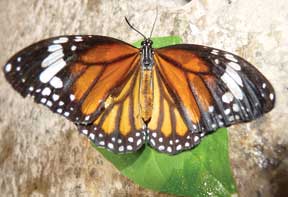Geetha Iyer
Where can one find a tiger that flies or one with six legs? Six legs is the clue and if you have guessed it right, then, yes, we are talking about the tigers in the world of insects. Tiger is the common suffix added to the names of certain species of butterflies that are cosmopolitan in their distribution. In India, while many of them are abundant and common, there are some that are found only in specific habitats or biomes.
 Introduction
Introduction
Tiger butterflies belong to the family Nymphalidae, to the sub-family Daniane. All Nymphalids are also called Brush-footed butterflies. There is a reason for this name. The first pair of legs, the forelegs are very small and quite useless. They are also covered by hairs giving them a brush-like appearance. This feature is seen in all Nymphalids, except those butterflies that are commonly referred to as Beaks.
Tigers or these Daniad butterflies are also known as Milkweed butterflies – a reference to the plants on which the caterpillars can be found. They are not the only milkweed butterflies, but this article is restricted to the description of tiger butterflies.
The abundant presence of these butterflies could be attributed to the abundance of the food plants available for their caterpillars. Milkweeds, Oleanders, and figs are seen everywhere in our country. The Banyan and Peepul (representatives of the Fig family) are fortunately not cut down because of their religious significance. Similarly Nerium (Arali in Tamil) is cultivated and used in the south in temples or at homes for rituals. Calotropis (madder) grow even in water-scarce conditions. It is also another plant that has both religious and medicinal significance. Is it any wonder then that the tiger butterfly is so common? These butterflies have tough leathery integuments that taste quite unpleasant to birds and lizards that generally like to eat them. Their tough integuments protect them and therefore are not killed easily. Like some others in the insect world, they can feign dead if caught. An excellent exploratory project on these butterflies can be done in middle school. The objective of the project would be to discover the role played by the food plants in the survival of these butterflies. Another equally interesting project would be to explore why other butterflies mimic them.
The author is a consultant for science and environment education. She can be reached at scopsowl@gmail.com.
